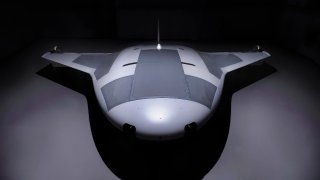DARPA’s Manta Ray UUV 'Underwater Drone' Could Transform the U.S. Navy
DARPA has successfully completed the first in-water testing of the Manta Ray uncrewed underwater vehicle (UUV) prototype, developed by Northrop Grumman.
Summary: DARPA has successfully completed the first in-water testing of the Manta Ray uncrewed underwater vehicle (UUV) prototype, developed by Northrop Grumman. This testing phase, conducted off the coast of Southern California, confirmed the UUV's hydrodynamic capabilities and operational readiness through various propulsion and steering methods.
-The Manta Ray is designed for extended, autonomous missions in remote oceanic environments, featuring modular construction for easy transport and field assembly. Its efficient buoyancy-driven propulsion and multiple payload bays make it adaptable for diverse naval missions.
-The U.S. Navy sees the Manta Ray as a potential game-changer for long-duration undersea operations, including mapping, mine detection, and surveillance, enhancing security for both military and commercial maritime activities.
DARPA's Manta Ray UUV Prototype Triumphs in Initial Sea Trials
The Defense Advanced Research Projects Agency (DARPA) has moved forward with its Manta Ray uncrewed underwater vehicle (UUV) prototype and completed the first in-water testing. The Manta Ray, which was built by defense giant Northrop Grumman, completed full-scale, in-water testing off the coast of Southern California earlier this year. The tests demonstrated at-sea hydrodynamic performance, including submerged operations using all of the vehicle’s modes of propulsion and steering: buoyancy, propellers, and control surfaces.
“Our successful, full-scale Manta Ray testing validates the vehicle’s readiness to advance toward real-world operations after being rapidly assembled in the field from modular subsections,” said Kyle Woerner, DARPA program manager for Manta Ray. “The combination of cross-country modular transportation, in-field assembly, and subsequent deployment demonstrates a first-of-kind capability for an extra-large UUV.”
Like a Fish in Water
As previously reported, the Manta Ray’s design was modeled on the aquatic creature, and it is reported to be outfitted with two rear propellers for movement, while it was also designed to operate for extended periods in oceanic environments inaccessible to humans. The UUV was developed in partnership with Seatrec—a renewable energy company—to enhance the understanding of marine environments and operate independently for extended periods.
The prototype was shipped in subsections from the build location in Maryland to its test location in California. The demonstrated ease of shipping and assembly supports the possibility of rapid deployment throughout the world without crowding valuable pier space at naval facilities.
“Shipping the vehicle directly to its intended area of operation conserves energy that the vehicle would otherwise expend during transit,” said Woerner. “Once deployed, the vehicle uses efficient, buoyancy-driven gliding to move through the water. The craft is designed with several payload bays of multiple sizes and types to enable a wide variety of naval mission sets.”
Northrop Grumman completed the assembly of the Mantra Ray earlier this year.
Long-Haul UUVs
The United States Navy aims to develop and demonstrate a new class of long-duration, long-range, payload-capable UUVs ready for persistent operations in dynamic maritime environments. DARPA is engaging with the sea service on the next steps for testing and transition of this technology.
According to Northrop Grumman, the Manta Ray is “payload-capable to support a variety of missions,” while it can operate without the need for on-site human logistics. It can anchor to the seafloor and hibernate in a low-power state, while it is also modular, which could allow for different mission-specific components.
The U.S. Navy hasn’t disclosed exactly what roles the UUV could be employed in, nor have the Manta Ray’s dimensions been disclosed. However, it is apparently large enough that it could serve as a mother ship for smaller UUVs. It was designed for easy transport and assembly on-site from five standard shipping containers, so it could likely be launched from a dock or even a ship at sea.
There has been speculation that the Mantra Ray could be outfitted to conduct undersea mapping, mine detection, and passive surveillance. In the latter role, it could be utilized to monitor for underwater threats to a carrier strike group or even aid in protecting commercial shipping.
Northrop Grumman was awarded a Phase 2 contract in 2021 to continue work on the Manta Ray program that began a year earlier. Phase 2 called for North Grumman Systems Corporation and Martin Defense Group to each build a full-scale tech demonstrator. It now appears the tests are well underway with the demonstrator.
A second Manta Ray performer, PacMar Technologies, is continuing testing of its full-scale energy harvesting system.
Author Experience and Expertise: Peter Suciu
Peter Suciu is a Michigan-based writer. He has contributed to more than four dozen magazines, newspapers, and websites with over 3,200 published pieces over a twenty-year career in journalism. He regularly writes about military hardware, firearms history, cybersecurity, politics, and international affairs. Peter is also a Contributing Writer for Forbes and Clearance Jobs. You can follow him on Twitter: @PeterSuciu. You can email the author: [email protected].


